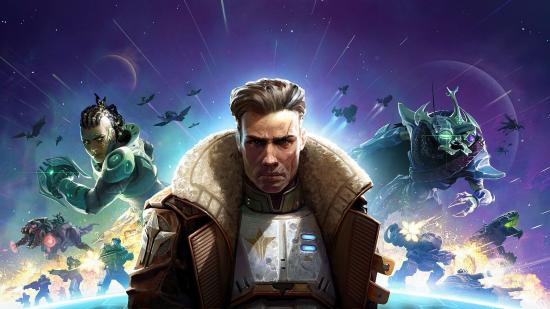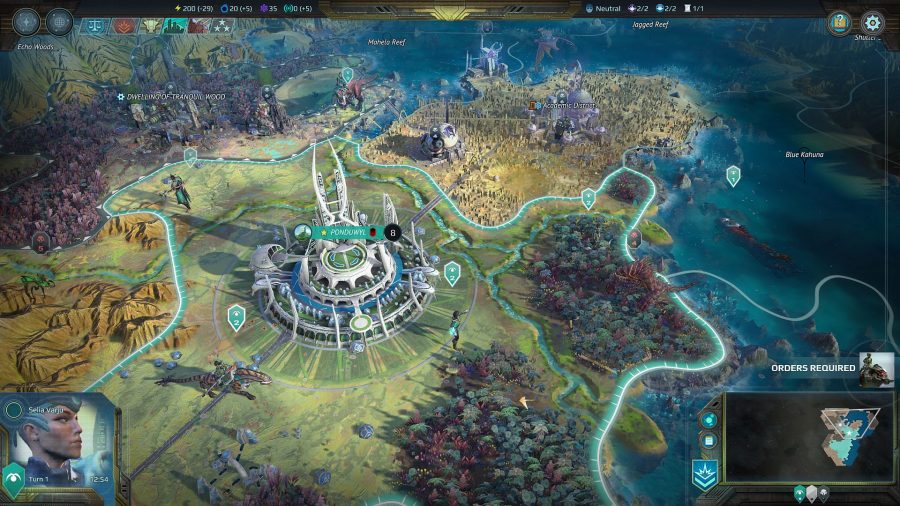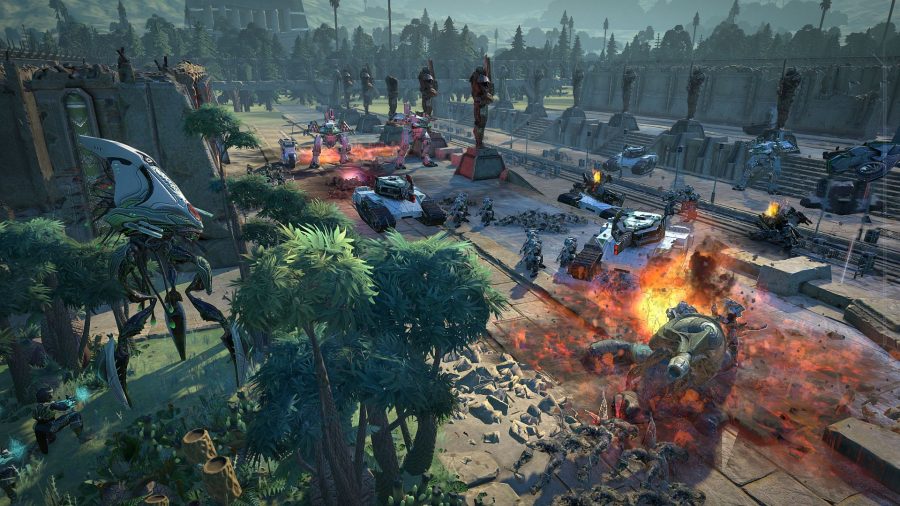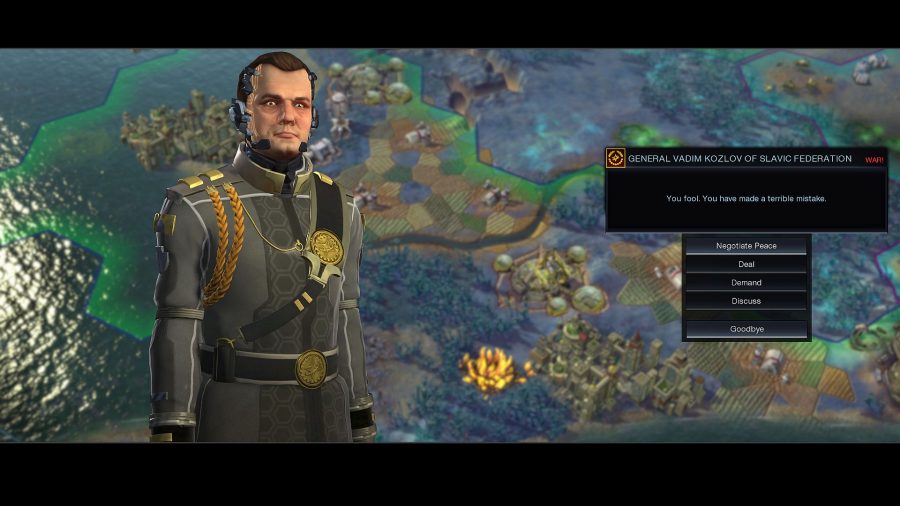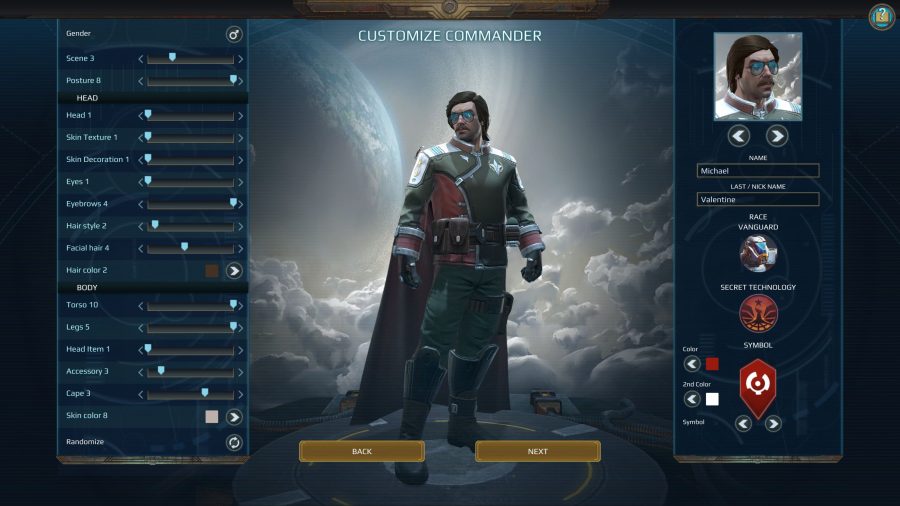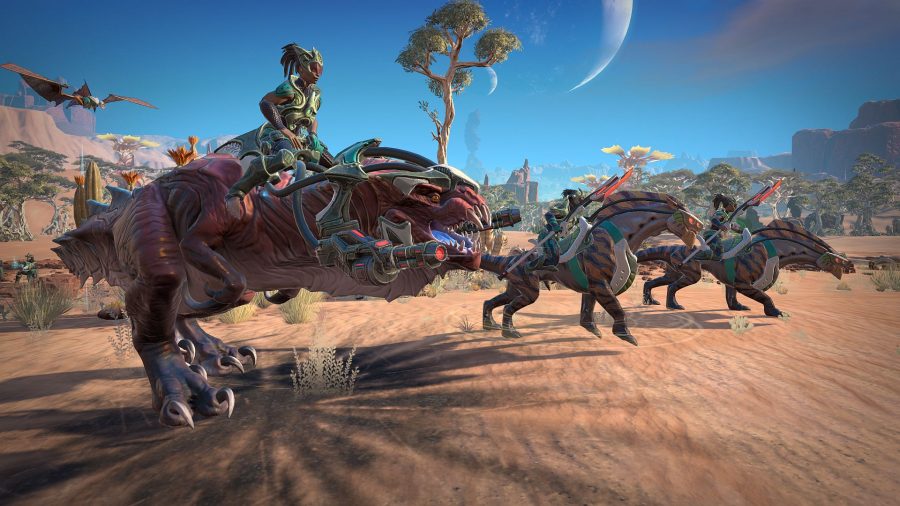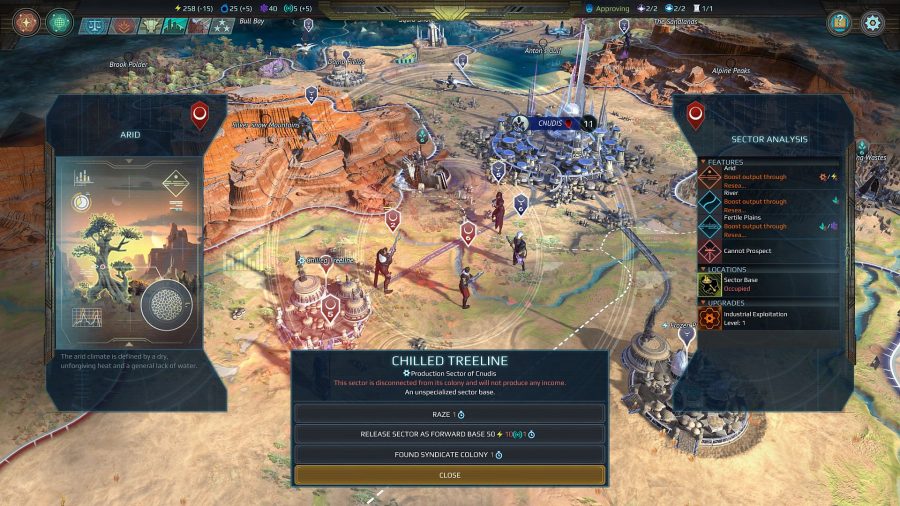Age of Wonders: Planetfall is about to take a risk. Abandoning the fantasy setting that built its fanbase, the long-running strategy series is reaching for the stars in embracing science fiction.
Fortunately – as you can read in my hands-on preview – the underlying gameplay has had a more cautious refinement. If it ain’t broke, and all that. Tactical battles embrace and evolve XCOM, while the strategic layer adds meaningful new choices to the development of your empire. But what problems are those changes seeking to solve, let alone the more radical shift in setting? How did developer Triumph Studios approach the challenge of creating a new fiction from scratch? And what about cyber dire penguins?
We spoke with designer Benny Arents, and senior designer and programmer Tom Bird, about all these topics and more. Read on for answers.
PCGamesN: You mentioned that Planetfall was partly a response to certain criticisms of Age of Wonders III. Which criticisms specifically?
Tom Bird: One was that the world map layer felt underdeveloped – specifically, its economic aspects. In Age of Wonders III, you plonk down a city to capture nodes, those nodes give you income, you use that income to make more cities, to capture more nodes, and it’s a circle.
People wanted more; they wanted more decisions, and more decisions that meant something, beyond simply ‘what do I grab next, and how do I grab it.’ So a lot of work has gone into ensuring that the game offers those kinds of choices; risk, reward, and alternatives, optimal paths here but also a sub-optimal path that is optimal in other ways.
The new exploitation system is an example of this, right?
Benny Arents: Yes. Different terrains and different biomes will all determine the potential of sectors that you acquire. But you don’t have to use these sectors to their full potential if you don’t want to – it might be better for you to make a sub-optimal choice now to increase the growth of your colonies, and then maybe switch that over later on. We also have landmark structures that give strong bonuses in single resources. Players will be fighting over territory to claim these landmarks, which can really boost their empire and get ahead of others.
And interestingly I’ve just come across a fungal mountains sector, which doesn’t actually have an optimal exploitation.
Bird: No, but you also have these specialisations, which affect the whole colony. So you might end up saying, ‘I’m going to take research, not because this is actually good for research, but because the research specialisation gives all units built in the colony this huge bonus’. And may be more important than a third energy sector – maybe you don’t need more energy right now. So those kind of choices, while sub-optimal in theory, are actually optimal in your situation.
Arents: And this is how you can really specialise your colonies. For example, if you’re building a colony that’s focused on making units, sure, you can build a lot of production in that colony to speed that up, but if you choose an energy specialisation next to that you can lower the upkeep of these units. But then if you choose the research customisation in combination with production, you’ll get units that gain experience faster and therefore will become stronger as long as you keep them alive in the world map.
What’s the second criticism you’re looking to address?
Bird: In Age of Wonders III, if you look at the racial line-up, effectively it followed a template. Every race had a swordsman, every race had an archer, every race had a support unit, every race had cavalry. There are clear differences between them, often a dwarven boar rider is quite a different unit to a goblin warg rider. But the templating meant that they feel the same in certain respects.
What we’ve tried to do in Planetfall is every single unit – with a couple of exceptions – has a gimmick, and the exceptions are so rare that not having a gimmick feels like gimmick. The Vanguard Trooper just shoots a gun and throws a grenade, but he’s the only person that does that. So we’ve really tried to give each unit its own role and identity so that you’re not like ‘elves feel just like dwarves.’
Arents: You’ll be very hard-pressed to put two units next to each other in Planetfall and say they’re kind-of the same. Each of them is unique, has different abilities, and has a whole different backstory. There’s a very strong racial identity, as well.
And was enabling all this the main reason for the move to sci-fi, or was there something else that appealed?
Arents: We were always very interested in sci-fi. You have all these very strong space 4X games like Beyond Earth, Alpha Centauri, Sword of the Stars, Sins of a Solar Empire, and we thought the Age of Wonders formula would work well in a sci-fi setting, so that’s what we try to explore with Planetfall.
Read more: Scan our first Age of Wonders: Planetfall impressions
Bird: We’ve made a lot of fantasy games. There were, I believe, four Age of Wonders games counting Age of Wonders II: Shadow Magic, and the Overlord games were also fantasy. So fantasy, although interesting, after a while, you know, we’re hearing people go ‘we want something different, something new’ and we all like science fiction like Star Trek, Star Wars, Dune, and it’s cool to try to take those ideas and put them into the game. It would be very hard to have cyber zombies in a fantasy game!
You’re essentially coming up with a new sci-fi canon from scratch. Was that daunting?
Arents: At the start it was a little bit hard, until we came up with the Star Union. The Star Union basically tied everything together, and made everything make sense in a way. Before, we were like: ‘What if we have, like, zombie cyborgs in space? What if you do this or do that…’ but as soon as we had the Star Union, everything had a shared origin. Suddenly we had this really strong narrative that we could build on, and it’s like: ‘Okay, now it’s all coming together. Now we’re building this world, this IP based on Age of Wonders, but making its own thing.’
Bird: It also makes the world a lot more interesting. Personally – this might be controversial thing to say – but I personally enjoyed Beyond Earth more than Civilization V, because I liked the sci-fi setting. I like making laser guns, I get bored creating guys with spears. But Beyond Earth was saying ‘this is an alien world’, and you land there and it’s like ‘Well, what have we got? Oh, this is purple!’ You know, it’s supposed to be a mysterious alien world, and it is, but the downside to that is it’s very hard for the player to relate to what they see. But by putting in a human empire, the player can go ‘Oh, this is a power plant. I know what a power plant is. These are roads, I know what roads are’. There’s a relatable reason for that to be there, which makes it more human.
What would you compare Planetfall’s lore to, just to give newcomers a sense of it?
Bird: Star Wars. Star Wars is the biggest sci-fi fantasy thing there. As far as I’m aware – I’m not an expert here – sci-fi is roughly split into two camps: hard sci-fi, which is where you try to be realistic, like Iain M. Banks, talking about technologies that could really exist. Then there’s science fantasy, which is in the future, but in many respects everything is magic.
Arents: We’re space opera, mixed with sci-fi fantasy. Star Wars was a huge influence of course, but we also looked at lots of books. Hyperion by Dan Simmons, for instance, was a very strong influence in creating the narrative.
Bird: Another way that it sort of resonates with Star Wars, which completely contradicts what I actually just said, is that hard sci-fi tends to be about the science fiction itself, and the economic and governmental implications. Whereas science fantasy is more about people, the characters, the stories. So by going for that route, the characters are much more front and centre.
We’ve seen a main character, Jack Gelder of the Vanguard. What can you tell us about the story and his role in it?
Arents: Jack was far away from home when the cataclysm happened. The tutorial [which ends with Jack returning to the Star Union via a centuries-long cryosleep] is a prequel to the main story. He’s on his way back home not knowing what he’ll find, and when he arrives, everything is in ruins. The Union no longer exists.
There are survivors – there are the playable factions but also the NPC factions all scattered across all of these planets, and during the campaign Jack is trying to piece together what actually happened, who survived, and how can we move forward. Every scenario is you trying to establish your empire on the ashes of the Star Union.
Bird: In a way, Jack represents the player. He comes in and is like ‘What is going on?’ The other races know who they are, like the Amazons and the Assembly, have a path, and a mission. The Vanguard, however – their very identity is gone. The whole point of the Vanguard is to guard the Star Union, and the Star Union is gone. Where did it go? As the Vanguard, that’s your job to find out.
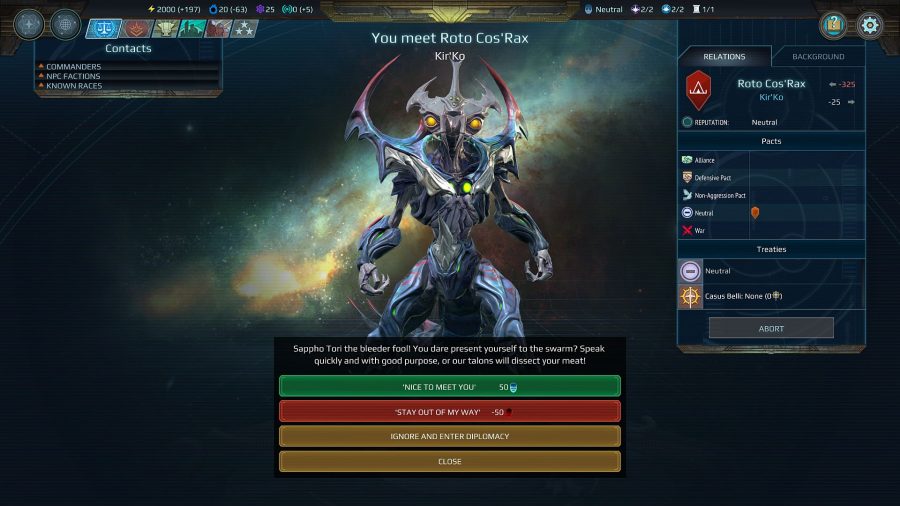
Arents: Every race has their own campaign, consisting of two missions. Then there’s a final mission where you can choose which of these factions that you played, in all these other campaigns, that you want to represent. That’s then the conclusion of this whole story arc. So you get to explore each faction individually, and their their own internal conflicts and struggles.
For example the Kir’ko are struggling with: ‘Okay, now that faster than light travel has been re-established and we’re getting into contact with all these remaining parts of the Star Union again, how do we treat them? They used to enslave us, but we broke free, so do we want vengeance? Do we want reconciliation?’ How do you want to approach the reunion with these people? You get to choose, in the campaigns.
Bird: One thing that’s very important to know about the campaign is you can make your own character. The race and the secret tech are both set, I believe…?
Related: Launch into the best space games on PC
Arents: The secret tech is set in the first campaign mission, but during that mission, you can unlock a second secret tech, and then you can switch if you want. The choices that you make in all these campaign missions are stored, so in the final mission, the consequences of all your choices, in all these six other campaigns, will be represented.
And as Tom said, you can customise your leader completely. So if you want to make Jackie Geller, the female Jack Geller, you can do that. If you want her to be bald and have an eyepatch and a scarf, you can do that, and that will carry over through all these campaign missions and the final mission as well. So if you create weird customs for every campaign, then in the last mission you’ll have all these weird people.
What are some of the coolest units we’ll get to play with?
Arents: I love ‘Barry’, the Barrager. He’s Kir’ko.
Bird: The Barrager! So, there is a degree of templating in that every race has an artillery unit, and the Kir’ko somehow ended up with two artillery – a psionic artillery called the Tormented, and the Barrager – aka ‘Barry’ – who is your biological artillery. He’s scatter artillery, isn’t he?
Arents: Yeah, he shoots very inaccurate projectiles with a big radius. So you point him at an area that generally contains hostiles, and he just starts lobbing biochemical bombs that destroy everything in their path. And the Tyrannodons of course, a fan favourite – a giant T-Rex-like monster with laser beams on its head. Can’t go wrong.
Bird: Oh! And the fucking Echo Walker. The Echo Walker is actually my favourite unit, by far. It’s inspired by Schrodinger’s Cat, and the theory that you can exist in two places at once until the waveform collapses and now there’s only one of you. The Echo Walker can create a clone of himself – same buffs, same debuffs, same mods, everything – but in another place. When he does that he still has one action point left, so he can still do something, and the clone also has an action point.
So what this means is you can run up to someone, create a clone behind them, and the clone punches them in the back of the head. When they turn around to see what just happened, the original punches them again in the back of the head.
There’s also a Voidtech mod that gives them grenades, so someone just discovered that what you can now do is run forwards, create a clone, and then just chuck two grenades at the target and absolutely obliterate them. Might need to nerf that somehow.
No chance of cyber dire penguins?
Bird: We’re not allowed to talk about that. It’s best if we don’t discuss cyber dire penguins. Penguins exist in the game. They have appeared in a video, I believe, a trailer. So we can confirm the existence of penguins, but as to the existence of evil pan-dimensional cyber penguins, we can neither confirm nor deny their presence or future presence.
Arents: Unfortunately.
Can you talk about naval warfare at all?
Bird: Yeah. Once you do a piece of research, you can move units onto the water and they automatically embark on transports. It’s very similar to Age of Wonders III – embarked units suffer a number of penalties to make them less effective. Each race has their own unique battleships – most races have two apart from one race that has one because they have so many floating units they don’t need it. Aircraft and floating units are not affected by this penalty, so some races are naturally better at water combat because they have better planes or because they have hovertanks.
Read more: Land on the best strategy games on PC
Arents: And then we have unique NPC dwellings or NPC factions whose bases only appear on the water. We have landmarks on the water, we have various hazards and resources that you can find on the water. So we tried to make the water a valuable part of the world for you to exploit and explore.
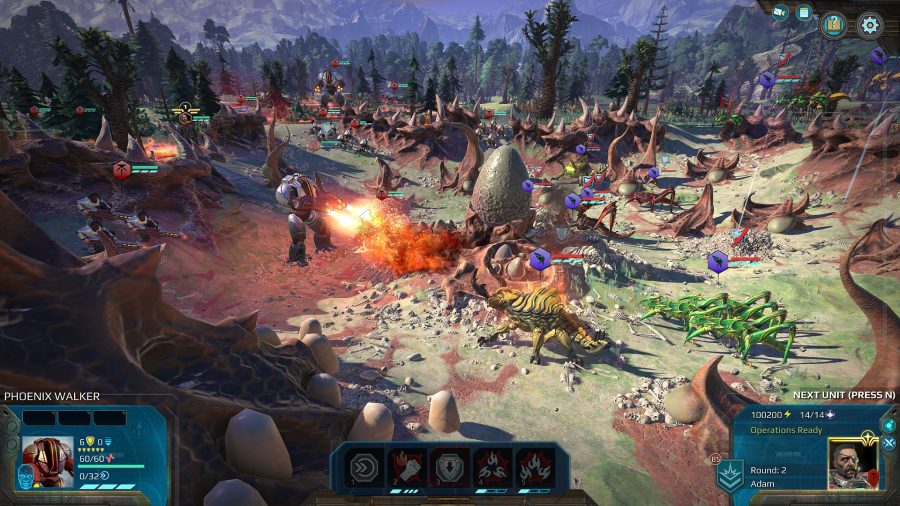
And of course, the Amazons have sharks with lasers on their heads.
Arents: Of course! No.
They don’t?
Arents: They don’t.
Bird: They have a floating octopus-tank?
Arents: There’s an octowhale in there, so it’s half whale, half octopus.
Bird: [proudly] That was me! I came up with that word. The octowhale.
